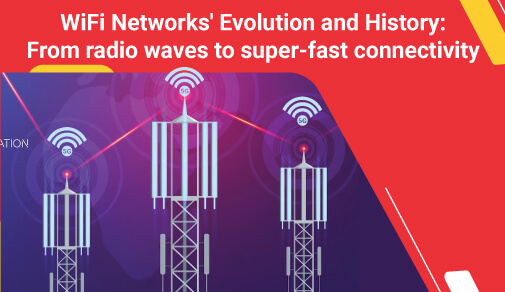History and Evolution of WiFi Networks
-
0
-
-
7 minutes

Wireless Fidelity, also referred to as WiFi, is a wireless communication technology that helps to connect electronic devices to the internet and have access to exchanging data wirelessly. It is based on radio waves working to transmit data between the device and the wireless router or access point.
WiFi allows users to access the internet, send emails, browse sites, engage in media platforms, and much more. This wireless networking technology has become a widely used technology these days. Users need convenient and flexible internet connections, from homes and offices to public places and educational institutions.
Let's dive into WiFi history and learn how it has evolved, impacting businesses and individuals.
Discovery of wireless communication
In the late 19th century, Heinrich Hertz discovered and verified radio waves. His experiments played a crucial role in the discovery of wireless communication. His experiments laid down the proof of electromagnetic waves that became the foundation of wireless networking technology.
Influenced by Hertz's experiment, Guglielmo Marconi applied the principles to practical wireless telegraphy and radio broadcasting. In 1901 he achieved a milestone when he transmitted the letter 'S' in Morse code from Cornwall in England to St. John's in Newfoundland – 3,500 km across the Atlantic Ocean.
Marconi became the first person to bag a Nobel prize in radio technology. The success of the first telegraph system then became the backbone for numerous inventions in communications and technology.
It was time to take a massive turn in advancing early wireless communication. The next big stop was radio broadcasting, but several paths were crossed to reach there.
· Wireless telegraphy paved the way for more experiments and demonstrations. After sending written letters on pages, it was time to shift to voice transmission.
· Voice transmission was verified by Reginald Fessenden when he conducted a broadcast on Christmas evening, where he transmitted whole music and lived vocal performance.
· The above invention led to the establishment of broadcasting stations and their regulation.
· In the 1920s and 1930's renowned networks such as NBC and CBS were formed. These stations offered a variety of programming, including news, music, dramas, comedies, and live performances.
· The Golden Age of radio started after this. People heavily relied on radios as the primary source of news, entertainment, and cultural programming for households worldwide.
· Modern radio broadcasting took over the world by colliding with digital broadcasting. This gave rise to Internet radio and satellite radio.
The emergence of wireless networking
Various radio-based networking experiments were carried out in the early 20th century by scientists and inventors, laying the groundwork for advancing wireless technologies. A wireless power and communication system was the idea of Serbian-American inventor and electrical engineer Nikola Tesla.
Tesla tested wireless power transmission in the early 1900s and proposed the creation of a worldwide wireless communication network.
Tesla's concepts and experiments formed the basis for later wireless networking technologies. The following big plot in the WiFi Timeline was the introduction of LAN.
Robert Metcalfe and his team designed ethernet. It was used as a local area networking technology that used coaxial cables to connect computers and devices in a network. With the availability of ethernet, LAN started to grab popularity. They were responsible for connecting devices within a limited area, such as an office, building, or campus, to communicate effectively.
Seeing such capability and demand, ethernet technology started maturing. Soon it could support fast speeds ranging from 100 Mbps to 1 Gbps and then reach up to 10 Gigabit and beyond.
Birth and growth of WiFi
In 1999, the Wireless Ethernet Compatibility Alliance (WECA) was formed to establish a unified wireless networking standard for interoperability and widespread adoption. In collaboration with the Institute of Electrical and Electronics Engineers (IEEE), the 802.11 group was created to develop this standard.
Eventually, WECA was rebranded as the WiFi Alliance to promote and certify wireless networking products. The term 'WiFi' was coined by a branding agency, inspired by the term 'Hi-Fi' used in audio systems, signifying high fidelity.
First Commercial WiFi Products
The introduction of the first commercial WiFi products marked a major milestone in the expansion of WiFi. These were based on the IEEE 802.11b standard. Here are a few first commercial WiFi products.
· Lucent ORiNOCO WaveLAN
· Apple AirPort
· Cisco Aironet
· Proxim Harmony
· 3Com AirConnect
All of the above-mentioned WiFi products contributed to the widespread development of WiFi standards. They made wireless connectivity accessible, allowing people to connect devices without the restrictions of physical cables. These products' release signalled the start of a wireless revolution, opening the door for WiFi technology's future development.
WiFi Technology and Functionality
WiFi has truly changed how users connect to the internet and communicate wirelessly. It provides fast and reliable wireless connectivity in homes, workplaces, and public places. Now here is a basic and compact detail about WiFi and its functionality.
Standards and frequency
WiFi operates on the standard set by the IEEE. To be more accurate, the specified was 802.11. Afterwards, there were different standards like 802.11a, 802.11b, 802.11g, 802.11n, 802.11ac (WiFi 5), and 802.11ax (WiFi 6). They provided great speed, performance, and improved features.
WiFi devices operate in different frequencies, including 2.4 GHz and 5 GHz. This frequency is directly affected by the standard and capabilities of the device.
Wireless Access Points (APs)
APs or access point is a device that creates a wireless local area network, or WLAN, usually in an office or a large building. They collect data from connected devices and send it to the right place, like other devices on the same network or the internet.
SSIDs and Authentication
WiFi networks are recognized by their Service Set Identifiers (SSIDs), which is nothing but a unique name assigned to the network. When the user is connecting their device to any WiFi network, they must follow a proper WiFi protocol.
The device must authenticate using security protocols like Wired Equivalent Privacy (WEP), WiFi Protected Access (WPA), or WPA2/WPA3.
Range and Coverage
The range and coverage of WiFi depend upon several factors. Both of them impact the functioning and output of the WiFi. Here are some factors that heavily effects the range and coverage:-
1. Transmitting Power
2. Antena design
3. Frequency band
4. Physical obstacle
5. Network design
6. Signal quality
WiFi in Everyday Life
The development of WiFi standards has reached the heights of perfection. Here are some ways in which WiFi has enhanced our lifestyle:
Smart Home Integration
Ranging from thermostats to lighting systems, all of these are smart home appliances controlled remotely by WiFi and provide users with comfort, convenience, and security at home.
Education and E-learning
WiFi has changed education delivery by making e-learning and online educational platforms possible. Regardless of their physical location, it enables students to access educational resources, participate in virtual classrooms, turn in assignments, and communicate with teachers and peers.
Wireless Printing and File Sharing
Printing and file sharing are both made easier by WiFi connectivity. Multiple devices on the same network can access wireless printers without physical connections.
Internet Of Things (IoT)
The IoT ecosystem is supported by WiFi, which links various smart appliances and devices. WiFi enables data communication and exchange between various devices, including wearable technology, industrial sensors, and smart home appliances.
Challenges and Future of WiFi
The WiFi timeline demonstrates the crucial role WiFi plays in today's world. Its rapid growth is essential for various tasks, and its future potential raises questions and challenges. Overcoming these challenges is vital for WiFi's continued evolution.
Spectrum Congestion
The available frequency spectrum gets more crowded as WiFi devices grow. Interference and poor performance may result from this congestion. Future technologies, like WiFi 6E, which utilizes the 6 GHz frequency band, are working to solve this problem by adding more spectrum for WiFi use.
Security concerns
WiFi networks are susceptible to security risks, such as network attacks, unauthorized access, and data breaches. Encryption protocols like WPA3 have been introduced to improve WiFi security. However, ongoing efforts are required to strengthen WiFi network security and guarantee the privacy and protection of user data due to the development of hacking techniques.
Power Consumption
WiFi equipment uses a lot of energy, especially when transmitting data. Portable device batteries may be affected by this. Future developments in WiFi technology will focus on lowering power consumption so that gadgets can run longer without quickly depleting their batteries.
Coverage and Range Limitations
Although WiFi technology has advanced to provide better coverage and range, some limitations remain, particularly in larger spaces or places with physical obstacles. Research and development are ongoing in overcoming coverage restrictions and ensuring reliable connectivity under challenging environments.
Conclusion
WiFi Technology's impact on our connectivity, communication, and access to information has been nothing short of transformative. It has become the backbone of the Internet of Things, connecting numerous devices and driving automation and efficiency across various industries.
The future of WiFi will be shaped by seamless integration with other wireless technologies, enhanced security measures, and the emergence of WiFi as a Service (WaaS) models.
Experience the power of lightning speed with our state-of-the-art fibre-optic network. Our WiFi plan ensures a seamless and uninterrupted connection, whether you're streaming your favourite movies and shows, playing online games, or working from home. Check out ACT Fibernet's WiFi plans to take advantage of the offer. Visit the website now.







